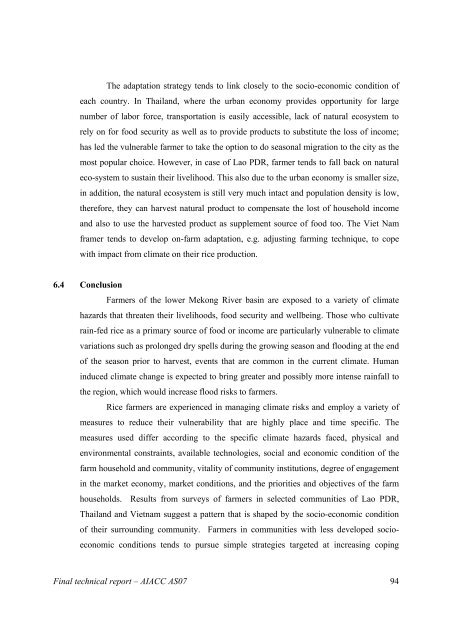Final Technical Report - weADAPT
Final Technical Report - weADAPT
Final Technical Report - weADAPT
- No tags were found...
You also want an ePaper? Increase the reach of your titles
YUMPU automatically turns print PDFs into web optimized ePapers that Google loves.
The adaptation strategy tends to link closely to the socio-economic condition of<br />
each country. In Thailand, where the urban economy provides opportunity for large<br />
number of labor force, transportation is easily accessible, lack of natural ecosystem to<br />
rely on for food security as well as to provide products to substitute the loss of income;<br />
has led the vulnerable farmer to take the option to do seasonal migration to the city as the<br />
most popular choice. However, in case of Lao PDR, farmer tends to fall back on natural<br />
eco-system to sustain their livelihood. This also due to the urban economy is smaller size,<br />
in addition, the natural ecosystem is still very much intact and population density is low,<br />
therefore, they can harvest natural product to compensate the lost of household income<br />
and also to use the harvested product as supplement source of food too. The Viet Nam<br />
framer tends to develop on-farm adaptation, e.g. adjusting farming technique, to cope<br />
with impact from climate on their rice production.<br />
6.4 Conclusion<br />
Farmers of the lower Mekong River basin are exposed to a variety of climate<br />
hazards that threaten their livelihoods, food security and wellbeing. Those who cultivate<br />
rain-fed rice as a primary source of food or income are particularly vulnerable to climate<br />
variations such as prolonged dry spells during the growing season and flooding at the end<br />
of the season prior to harvest, events that are common in the current climate. Human<br />
induced climate change is expected to bring greater and possibly more intense rainfall to<br />
the region, which would increase flood risks to farmers.<br />
Rice farmers are experienced in managing climate risks and employ a variety of<br />
measures to reduce their vulnerability that are highly place and time specific. The<br />
measures used differ according to the specific climate hazards faced, physical and<br />
environmental constraints, available technologies, social and economic condition of the<br />
farm household and community, vitality of community institutions, degree of engagement<br />
in the market economy, market conditions, and the priorities and objectives of the farm<br />
households. Results from surveys of farmers in selected communities of Lao PDR,<br />
Thailand and Vietnam suggest a pattern that is shaped by the socio-economic condition<br />
of their surrounding community. Farmers in communities with less developed socioeconomic<br />
conditions tends to pursue simple strategies targeted at increasing coping<br />
<strong>Final</strong> technical report – AIACC AS07 94
















